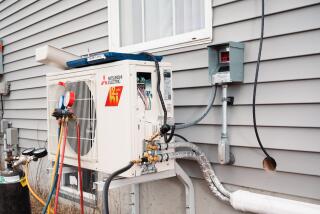Geodesic Dome Home Is Easy on Energy Use
- Share via
QUESTION: I am interested in building a unique-looking house that has low utility bills and I want to do much of the work myself to reduce the costs. What is the most energy-efficient type of kit home?
ANSWER: One of the most energy efficient and easiest to build are geodesic dome home kits. These are very unique and attractive homes, with standard kits ranging in floor space from about 900 square feet to more than 3,000 square feet with five bedrooms. For even more space and an interesting appearance, you can cluster several smaller kits together into one home.
There are four inherent characteristics of a dome home that make it extremely miserly with utility bills and especially air-conditioning costs. You can expect your utility bills to be as much as 40% less than for a similarly constructed and insulated conventional rectangular home.
First, with the basic rounded exterior shape of a dome home, there is about 30% less outside wall area than for a conventional rectangular home of the same floor space. Since the amount of heat loss (or heat gain in the summer) is directly related to the amount of exterior wall area, you can expect a substantial savings on your utility bills.
Second, the rounded exterior shape gives less resistance to wind flowing past it. This reduces pressure differences on the sides of the home, so there is less outdoor air infiltration (leakage) into it.
Third, a unique feature of a geodesic dome design is that there are no interior support walls needed. With the sloping outside walls and fewer interior obstructions, you can add many windows and skylights to provide more natural lighting. This holds down your electric bills and reduces the heat buildup from electric lights in the summer.
Fourth, the air inside of a dome home circulates naturally, so the heated air doesn’t end up at the ceiling, as in a rectangular home. The air tends to flow up the sloped side walls, collide in the center, and then drift down to the living area where you are. Therefore, you can have a high ceiling and open lofts without the typical energy efficiency penalty.
You and a couple of friends should be able to enclose the entire shell of a dome home in two weekends. All of the construction members in the kit are pre-cut and color-coded. You can also select many options such as 2 x 6 studs for extra insulation thickness, special skylights, and entrance extensions to individualize the style and add more open areas.
You can write to me for Utility Bills Update No. 018 showing floor plans for five unique styles (900 to 3,000 square feet) of dome homes, full-color exterior photos and a list of manufacturers of the kits. Please include $1 and a self-addressed envelope. Send your requests to James Dulley, Los Angeles Times, 6906 Royalgreen Drive, Cincinnati, Ohio 45244.
Buy Refrigerator With an Auxiliary Door
Q: I am considering getting a new refrigerator and I want it to be energy efficient. One model has a small auxiliary door feature. How much will that feature save me so I can tell if it is worth the extra cost?
A: A small auxiliary door will save quite a lot of electricity over the life of your refrigerator. It saves energy because you only need to open the small door to get out frequently eaten foods. Therefore, less cold air is lost than if you opened the regular large door.
Based on a typical 16-cubic-foot refrigerator, opened an average 27 times a day, about 1,000 BTU of energy are wasted each day. The small auxiliary door would cut this loss and save several cents per day. That could add up to more than $100 saved over the life of the refrigerator.
Letters and questions to Dulley, a Cincinnati-based engineering consultant, may be sent to James Dulley, Los Angeles Times, 6906 Royalgreen Drive, Cincinnati, Ohio 45244.
More to Read
Sign up for Essential California
The most important California stories and recommendations in your inbox every morning.
You may occasionally receive promotional content from the Los Angeles Times.






